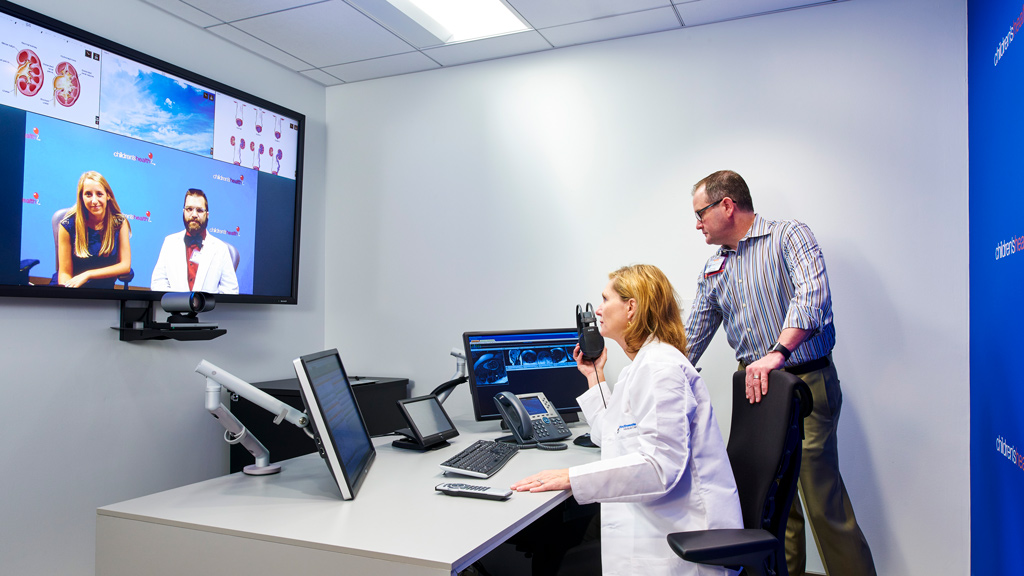Transitioning to a Virtual World of Health & Wellness
May 22, 2020 | By Randy Guillot and Tama Duffy Day
Editor’s Note: This post is part of our ongoing exploration of how design is responding to the COVID-19 pandemic.
In early 2018, we reported that the number of telehealth or virtual health interactions — which can take the form of live video interface between patients and practitioners, remote patient monitoring, and remote storing and forwarding of patient data — would surpass the number of physical visits by 2024.
The COVID-19 pandemic has shattered those predictions. It is now predicted that virtual care visits will rise to more than one billion visits this year, catapulting us into what could be the largest change of workflow and expectations around patient-doctor interactions in the modern medicine era.
That’s a big statement — but consider some recent examples:
- In February, our clients at Partners Healthcare provided 1,500 virtual visits. In March, with the virus spiking in Massachusetts, they did 90,000 – in April it was up to 250,000 and rising.
- Another client, MedStar Health, has delivered more than 100,000 telehealth sessions during the recent outbreak and believe in some ways, the virtual visit might improve the patient-doctor dynamic.
- In a radical about-face, the U.S. government and the insurance industry have actively encouraged the use of telemedicine, eliminating years old barriers to reimbursement.
“The transition to telehealth has been swift and staggering,” says Sonia Singh, VP of Healthcare Consumerism at AVIA, a Chicago-based healthcare consultant. “One of my favorite stories is a health system that described doing 100,000 virtual visits last month. When we asked how that compared to prior months they replied, ‘we’ve done 12.’ We said, ‘You mean 12,000?’ And they said, ‘No, 12.’”
The landscape of virtual care has leapt ahead a decade or more, and it is creating a massive shift in operations at a time when a historic financial decline has hit the healthcare industry.
Rethinking the healthcare facilityWhat is the role of space in a ‘virtual’ interface between caregiver and patient? One thing is for certain: flexibility and adaptability to these new workflows will leave many traditional clinic spaces flatfooted as they try to adapt. Real estate costs that were invested in the traditional ‘one size fits all’ exam room layouts will have trouble flexing to the new normal of virtual visits one day and physical exams the next.
Telehealth facilities have stringent design demands, which is why existing medical facilities will need to flex to be more like workplaces in other industries such as technology , law , and government. These spaces provide ergonomic workstations for extended periods of technology usage — something existing medical facilities aren’t set up for. They must also be secure, reasonably soundproof, and ready for 24/7 operations. Embedding high-quality audio-visual equipment isn’t an option — it’s a requirement.
Private rooms will have to be balanced with other communal programmatic options to make sure healthcare workers have a balance to their day and don’t feel socially isolated. Since telehealth providers have less in-person human contact, it will be even more important for them to have access to fitness rooms, engaging social spaces, and a connection to nature via terraces, balconies, rooftops, or windows.
Before the COVID-19 crisis struck, some top-tier institutions had already begun to imagine a virtual future. At Partners Healthcare in Boston, Gensler is designing a new ambulatory care service line and rolling out multiple buildings around Massachusetts. Understanding that the traditional model of care would change in an era of increased virtual care, flexibility and adaptability drove early design decisions around the exam room ecosystem.
The result was a “kit of parts” for buildings of various sizes depending on need up to 60,000 square feet, built around a flexible exam room module. These modules of rooms can be reconfigured quickly between an assortment of small, medium, and large room sizes depending on the percentage of virtual health visits.
Rather than being about standardization, this is about choice as they flex up or down in a virtual care world, allowing a workflow that keeps physicians and caregivers in the care environment without tying up full sized exam rooms for virtual visits.
As institutions plan ahead, projects are now expected to have the ability to flex and provide for up to 80% virtual visits if necessary.
For example, we have already modified the design of Community of Hope, a women’s health clinic in Washington DC, so that every exam and consult room will have telehealth capabilities. Although the facility largely provides primary care and women’s health services, even OB-GYN specialists are finding telehealth strategies to increase communication, offer childbirth and lactation classes, and maintain care remotely.
We also implemented a robust telehealth program for Hoag, a regional health care delivery network in Orange County, California. They use the system to connect to patients with chronic medical conditions such as diabetes and high blood pressure, as well as to patients who need specialized care for acute illnesses. Robert T. Braithwaite, president and CEO of Hoag, anticipates that “telehealth options will flourish even after the pandemic is over.”
The challenges of telehealth and behavioral healthMany in the health care industry share Braithwaite’s belief, especially because the crisis has expanded the need for behavioral health services. Unfortunately, treating behavioral health through virtual means presents unique challenges.
For some, telehealth is a very good substitute for an in-person visit. For others, the lack of a physical visit and the assistance that comes with it can exacerbate the issues. Challenges of self-direction or other cognitive and organizational disabilities can make even the planning around virtual visits difficult.
The continuous monitoring of the relationship — not just the appointment — is still key to effective mental health treatment. This is why it’s vital to educate caregivers about the virtual health process and provide them with the right technology solutions.
There are success stories to learn from. Our client at Nationwide Children’s Hospital, hosts of the 2020 Behavioral Health Summit, has learned quickly. “Telehealth is well-suited to mental health care at Nationwide Children’s,” they tell us. “It helps overcome barriers like poor access to transportation, and some children feel more comfortable receiving care at home than they do in a provider’s office.”
Where we go nowThe predictions we made in 2018, though now accelerated, hold true: “If telemedicine becomes a titanic industry changer, it will do so in large part by its enabling of genuine human connections — between practitioners and patients separated by vast distances, as well as among practitioners separated by just a few feet. Such fostering of human connections presents a significant design opportunity. Large-scale telemedicine spaces that get it right will enable healthy, happy, and meaningful experiences for practitioners, resulting in more effective delivery of quality care.”
Now more than ever, we believe that understanding the user interface to create real connections between caregiver and patient is critical. People expect, demand, and deserve seamless experiences. Rapidly accelerating technologies around touchless screens, remote monitoring, and sensor technology are part of an endpoint solution that will help people feel more comfortable. Yet some serious — and potentially timeless — hurdles remain. How do you pick up more ambient indicators of a patient’s well-being remotely, for example, particularly if dealing with the hurdles of a learning or language challenge?
Although technology is an important and essential enabler, the real opportunity comes when you design the entire virtual ecosystem of care, addressing the full patient and caregiver experience both physically and digitally.
For media inquiries, email .

